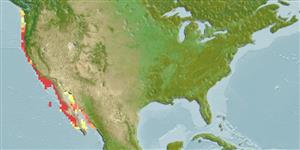>
Pleuronectiformes (Flatfishes) >
Paralichthyidae (Large-tooth flounders)
Etymology: Paralichthys: Greek, para = the side of + Greek, ichthys = fish + Greek, suffix, oides = similar to (Ref. 45335).
More on author: Ayres.
Environment: milieu / climate zone / depth range / distribution range
экология
морской; солоноватоводный демерсальный; мигрирует в океане (Ref. 51243); пределы глубины 0 - 183 m (Ref. 2850), usually 0 - 60 m (Ref. 122321). Subtropical; 48°N - 24°N
Eastern Pacific: Quillayute River in northern Washington, USA to southern Baja California, Mexico. Also in northern Gulf of California (Ref. 9330).
Length at first maturity / Size / Вес / Возраст
Maturity: Lm 47.3, range 47 - 51.3 cm
Max length : 152 cm TL самец/пол неопределен; (Ref. 2850); наибольший вес (опубликованные данные): 33.0 kg (Ref. 9330); наибольший возраст (опубликованны данные): 30 годы (Ref. 33520)
Adults are found mostly on sandy bottoms near shore to 183 m depth. Juveniles are common beyond surf line, larvae settling in bays and estuaries (Ref. 122321). Adults feed during the day (Ref. 9643) on fishes and squids, often well off the bottom. An important sport and commercial fish. They are caught with trammel nets (Ref. 9330). Marketed as fresh fillet (Ref. 9330). Adults migrate to shallower waters to spawn (Ref. 9643). Has very sharp teeth and is known to bite if handled (Ref. 13513).
Distinct pairing (Ref. 205). They are batch spawners that exhibit indeterminate fecundiity and undergo asynchronous ovarian development (Ref. 122336). Spawning interval is between 7 and 14 days while spawning frequency is around 12 to 13 times per year.
Eschmeyer, W.N., E.S. Herald and H. Hammann, 1983. A field guide to Pacific coast fishes of North America. Boston (MA, USA): Houghton Mifflin Company. xii+336 p. (Ref. 2850)
Статус Красного Списка МСОП (Ref. 130435: Version 2024-2)
Угроза для людей
Traumatogenic (Ref. 13513)
Использование человеком
рыболовство: коммерческий; объект спортивного рыболовства: да
дополнительная информация
инструменты
Специальные отчеты
Скачать в формате XML
ресурсы в Интернет
Estimates based on models
Preferred temperature (Ref.
123201): 12.4 - 23.9, mean 19.8 °C (based on 48 cells).
Phylogenetic diversity index (Ref.
82804): PD
50 = 0.5000 [Uniqueness, from 0.5 = low to 2.0 = high].
Bayesian length-weight: a=0.00646 (0.00364 - 0.01145), b=3.15 (3.00 - 3.30), in cm total length, based on LWR estimates for this species & Genus-body shape (Ref.
93245).
Trophic level (Ref.
69278): 4.5 ±0.63 se; based on food items.
устойчивость к внешним воздействиям (Ref.
120179): низкий, минимальное время удвоения популяции 4.5-14 лет (K=0.08; tmax=30; tm=2.6).
Fishing Vulnerability (Ref.
59153): Moderate to high vulnerability (55 of 100).
Climate Vulnerability (Ref.
125649): High vulnerability (61 of 100).
Nutrients (Ref.
124155): Calcium = 38.8 [16.9, 81.8] mg/100g; Iron = 0.81 [0.38, 1.56] mg/100g; Protein = 17.1 [14.7, 20.3] %; Omega3 = 0.207 [0.112, 0.387] g/100g; Selenium = 40.7 [19.2, 95.9] μg/100g; VitaminA = 5.82 [1.41, 25.97] μg/100g; Zinc = 0.371 [0.244, 0.589] mg/100g (wet weight);
